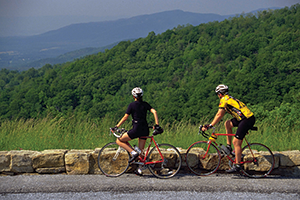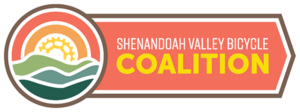This post appeared on the Virginia Business Magazine website on March 28, 2014 read the original article can be found here: http://www.virginiabusiness.com/news/article/recreational-asset
Recreational asset
The valley’s terrain and views make it a biking destination
March 28, 2014
by James Heffernan

When Kyle Lawrence came to Harrisonburg in 2003 to attend James Madison University, he was quickly drawn to the local biking scene. “There are amazing riding opportunities here, and a really great community, too.”
With more than 1,000 miles of scenic country roads and an extensive network of greenways and trails that cut through the nearby George Washington National Forest, the Shenandoah Valley is gaining national recognition as a premier biking destination.
“Biking is probably the single biggest recreational asset we have,” says Lawrence, who is president of the Shenandoah Valley Bicycle Coalition, a local advocacy group.
The coalition was formed in 2008 with the merger of the Shenandoah Valley Bicycle Club, a road-cycling club formed in 1982, and the Shenandoah Mountain Bike Club, which began in 1996. The coalition envisions an active and organized cycling community in the central Shenandoah Valley representing all types and levels of cycling and cyclists.
Although best known for mountain biking — the region is recognized as a bronze-level destination by the International Mountain Bicycling Association — the valley gradually is becoming a complete biking destination, Lawrence says. “What separates us from a place like Colorado, which has amazing mountain biking, is that we also have great road riding — not only the views, but the low traffic. It’s rare that an area can offer both. That’s what makes this place special from a recreational standpoint.”
Motorists in the Shenandoah Valley have long been accustomed to sharing the roadways with bicyclists, including recreational riders, area college students and members of the local Mennonite community.
“It’s such an accepted practice here already,” says Jason Burch, 31, who was born and raised in Dayton in Rockingham County. “Folks out here have been riding alternative modes of transportation since the area was first settled.”
A multisport athlete, Burch got hooked on mountain biking after returning home from college. He now rides 50 to 100 miles a week, weather permitting. “All of the country roads around here are fair game, and to have the George Washington National Forest here in our backyard, it’s just incredible,” he says.
The region’s natural beauty and challenging terrain draw hundreds of competitive back-country riders annually.
Since 1998, Harrisonburg-based Shenandoah Mountain Touring has hosted the Shenandoah Mountain 100, a 100-mile mountain bike race that begins and ends at the Stokesville Campground in Augusta County. The race is part of the Virginia Mountain Biking Trail, which links eight existing trails systems stretching 450 miles from Strasburg to Damascus, mostly on public land in the George Washington and Jefferson national forests.
In addition, events like the Alpine Loop Gran Fondo, which begins in downtown Harrisonburg and loops 105 miles through West Virginia while climbing 13,000 vertical feet, are securing the valley’s place as a road-racing destination. Last year’s race drew 600-plus riders from all over the U.S. and Canada.
For visiting cyclists and local enthusiasts alike, the valley offers more than a great ride. “A lot of places have great riding and scenery, but it’s in the middle of nowhere. There are no amenities,” Lawrence says. “But here, if you’re an experienced rider, you can ride 100 miles into West Virginia, on dirt roads where you never see a car, come back, go out to eat, go to a bar. We have a vibrant downtown. That’s a huge draw.”
The ‘power of the bicycle’
With its reputation among hard-core riders seemingly secure, there is a movement afoot to create the infrastructure to encourage local residents to take up biking.
“When you’re riding a bike, you don’t have a steel shell around you, so it engages you,” Burch says. “It’s a social activity. When you ride past a jogger or another rider, you acknowledge them. Plus you notice things more than you normally would.”
The coalition is involved in designing and building trails that are more accessible to beginning and intermediate-level mountain bikers. “We’re trying to lower the barriers to entry,” Lawrence says. “A lot of us have a childlike connection with biking. It’s fun.”
Since 1996, a group of people led by Thomas Jenkins, co-owner of Shenandoah Bicycle Co. in Harrisonburg, have been working on trails at Massanutten Resort, a popular recreation area, and in 2007 they began to clear trails for riding at Hillandale Park in the city. Since 2010, the coalition has received two Recreational Trails Program grants totaling more than $125,000.
Bicycles help builds better, stronger communities, too, coalition members say.
“To be able to bring that experience into the city is huge,” Burch says. “It promotes health and it reinforces the idea that you should be able to pedal someplace and do it for more than just recreation.”
The city of Waynesboro’s bike plan grew out of its greenway master plan, which was approved in 2001. The master plan set goals and objectives to provide safe trails as an alternative to vehicular traffic to connect Waynesboro’s commercial district with surrounding recreational attractions.
Phase One, completed in early 2012, is a 1-mile stretch starting from Loth Spring/YMCA and ending at the Dominion Pavilion in Constitution Park. The 10-foot wide trail complete with trees and benches is designed to increase access to the South River and to attract tourists, residents and new businesses to downtown.
Phase Two will extend the trail by 1.2 miles, ending at North Park. It is slated for completion later this year. The greenway project has been funded with federal and state grants as well as local contributions.
“Our greenway trail has been so well received,” says city planning director Michael Barnes. “Even before it was open, people of all ages were out walking on it.”
Waynesboro’s bike plan also includes bike lanes within the city limits. “We did an assessment of our streets to determine where bike lanes could be added safely and help connect riders with destinations including downtown, parks and schools,” Barnes says. The first of these lanes were completed last year during repaving season, and others are scheduled to follow in the next three to five years.
In Harrisonburg, residents have been working with city leaders to design and build what will be known as the Northend Greenway, a 2.5-mile bicycle and pedestrian path connecting neighborhoods on the north end of Harrisonburg with the downtown district via public green space. Those riders wanting to travel farther — to JMU, for example, or Purcell Park on the other end of town — will be able to easily connect with existing bike and pedestrian infrastructure to continue their journey.
Jenkins, who has been active with Northend Greenway, says the project will not only provide children and families with safe and naturally beautiful spaces for recreation; it will serve as a model of an effective alternative transportation infrastructure for Harrisonburg. And that, he says, is what resonates with local leaders. “They’re starting to see the value.” The project is expected to break ground in 2016.
Meanwhile, JMU is busy developing a Bicycle and Pedestrian Master Plan of its own. Planning efforts began in December 2012 with the creation of an advisory committee that includes JMU faculty, staff and students; representatives from bicycle coalitions, bike shops and proponents; and advisers from the city of Harrisonburg and Central Shenandoah Planning District Commission staff.
“We’re creating this big picture where you can get places easily, comfortably and safely by bicycle,” Lawrence says. “That, too, is gaining us national attention.”
Becky Johnston, a health promotion specialist at Sentara RMH Medical Center and a Shenandoah Valley Bicycle Coalition member, works with schools in the local community to encourage walking and bicycling to and from school through the Virginia Safe Routes to School program.
So far the program has been awarded $17,000 in mini-grants for bikes, bike racks and bike helmets for low-income households, as well as for educational materials, equipment, and special events like Walk and Bike to School Day. Largely because of Johnston’s efforts, the city was able to eliminate an entire bus route.
“The ultimate goal is to increase the numbers of children who enjoy walking or biking for transportation so that they will eventually become adults who use active transportation,” Johnston says. “This model, in theory, will lead to a healthier community.”
Going forward, the Shenandoah Valley Bicycle Coalition looks for the number of bike trips in the area to double or even triple in the next five to 10 years as more people start cycling, not just to work but for recreation.
“I see the trend continuing to grow,” Burch adds. “The impacts and the benefits of the movement to date are really going to accelerate. I see folks coming to our area for a travel destination, to bike downtown or to go on a 100-mile ride.”




